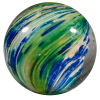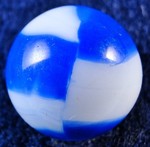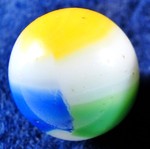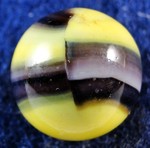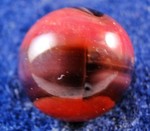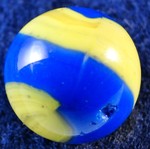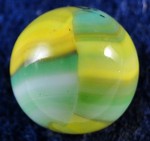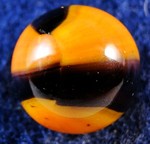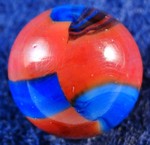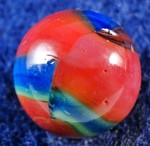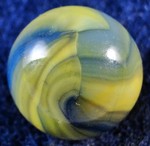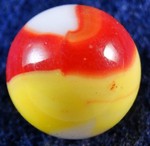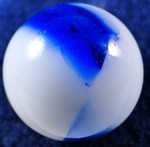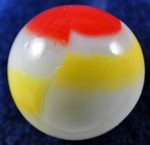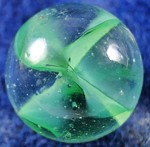BERRY PINK / MARBLE KING
Marble King was started in 1949 by Berry Pink and Sellers Peltier in St. Mary’s, West Virginia. The machinery was purchased from the Alley Glass Company. It was moved to Paden City, West Virginia, in 1958 after a fire destroyed the original plant.
Berry Pink had also been jobbing marbles since the 1920s under the trade name “Berry Pink, Inc.”.
Marble King continues to produce marbles today.
Marble King produced ribboned, patch & ribboned, cat’s-eye, and swirl marbles. Most are collectible today.
Marble King appears to have had different machinery that produced at least three separate seam marks. One type of machine produced a seam on the other side of the equator that was straight and at a perpendicular angle to the poles. A second type of seam has a “U” shape on either side of the equator. However, unlike Master Marbles that have the two “U”s going in the same direction around the marble, Marble King “U”s point towards each other. This seam design appears to be from an earlier machine and only shows up on Marble King marbles. A third seam type produces a seam on either side of the equator. One seam is straight and the other is “U” shaped. This seam type shows up on Marble King and Vitro Agate marbles.
Patch & ribbon marbles have a patch on one pole, a ribbon of a second color encircling the marble, a ribbon of the same color as the top patch encircling the marble, and finally a patch of the second color on the bottom pole. The marbles have two seams. They are made using a veneering method which puts a thin layer of the colored glass on a base of white glass. These marbles were produced until about 1975 and were marketed under the name “Rainbows”.
The most common Rainbow is white alternating with another color. The second color is usually red, blue, brown or green. There are Rainbows that are white with a color ribbon and patch consisting of two or three different colors. These are not quite as common.
The most collectible Rainbows are two different alternating colors (not white). Over the past fifteen years, a wide variety of color varieties have been found. These have descriptive names that have been given to them by collectors.
A representative sample, in ascending order of rarity: Bumblebee (yellow & black), Wasp (red & black), Cub Scout (blue & yellow), Girl Scout (green & yellow), Tiger (orange & yellow), Spiderman (red & blue), Green Hornet (green & black), Watermelon (red & green), Dragonfly (green and blue).
There are also hybrid examples that consist of three or more colors. Spidermen, Green Hornets, Watermelons, and Dragonflies have only been found in the 5/8” size. Girl Scouts and Tigers have only been found up to 3/4”. Larger examples (up to 1”) exist of Bumblebees, Wasps, Cub Scouts, and Bengal Tigers. Most of the more esoteric color combinations have only been found in the 5/8” size, indicating that many of these may have been short run.
A marble similar to the Rainbow is called the Blended Rainbow, because it is a patch and ribbon type and many of the color combinations are similar to Rainbows. In these marbles, the
colors are blended together. These marbles are usually about 5/8” or smaller.
There are also Rainbow patches, which are an opaque white base with two different colored patches covering the surface.
Another collectible Marble King marble is the Rainbow Red. This is a white base marble with an equatorial ribbon of red and a second equatorial ribbon of a different color, rather than a patch.
Since about 1975, there have been several types of new marbles produced that are very similar to vintage Rainbows in terms of color and pattern. These include two-patch Rainbows in opaque, translucent and transparent base, patch and ribbon Rainbows in translucent or transparent base, and marbles that are missing the patch but have the equatorial ribbon. Most of these are still in production.
Marble King has also produced a wide variety of clearies, opaques, and cat’s eyes. The most collectible are the four-vane multicolor cat’s eyes produced at St. Mary’s.
Cat’s eyes produced at Paden City have little value, due to their abundance.


